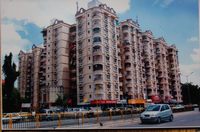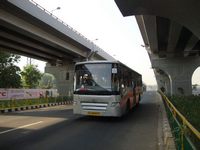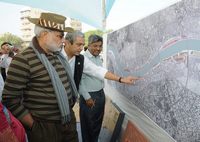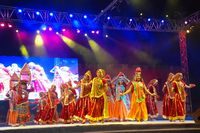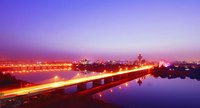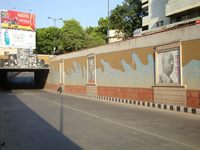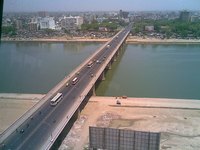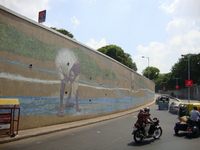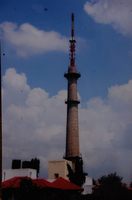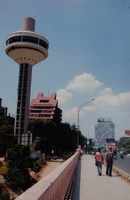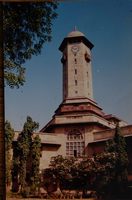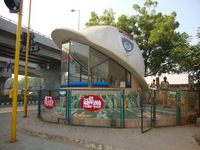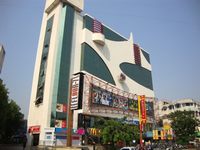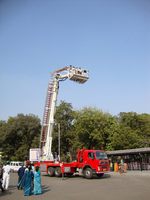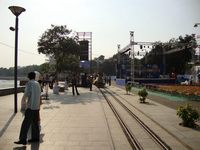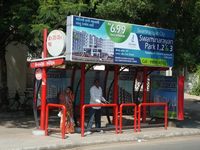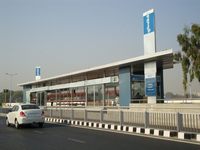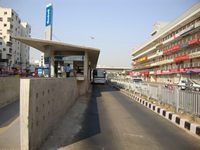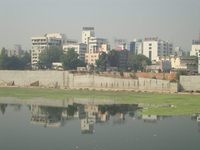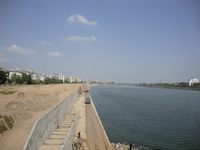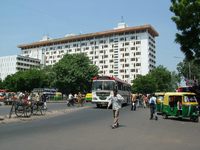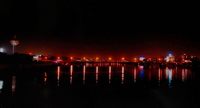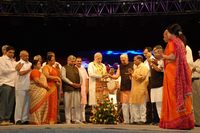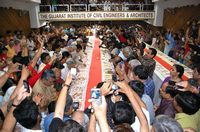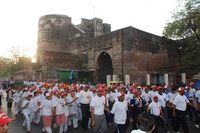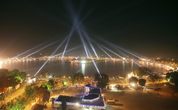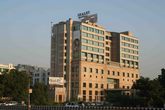Ahmedabad Municipal Corporation
The local self government of the city, namely Ahmedabad Municipal Corporation, emerged as the first people's representative council or democratic body in India. Ahmedabad had set an example of an autonomous body administrating the city during the British rule for the first time. This institution was unique and rich with its diversity since its inception.
The fort of Ahmedabad was shattered at many places and there were many big holes in it. Because of the floods in the river, the fort was damaged considerably. Mr. Bordel, the collector convened a meeting of the citizens of the city and formed 'Town Wall Fund Committee' on 21" April, 1831 to collect the funds for repairing the wall. The formation of the committee sowed the seeds of the renovation of the city. The committee levied tax at the rate of one percent on the sale of the commodities like ghee etc. Thus, a fund of two lakh rupees was raised and the committee took up the work of repairing the wall.
Sheth Ranchhodlal Chhotalal was nominated by the British Government as the first President of the municipality on 15th September, 1885. The Republic Municipality came into existence on 1st April, 1915 and Rao Bahadur Bhaishankar Nanabhai became the first elected president of the municipality.
Ahmedabad Barough Municipality came into existence in 1925. The centenary of Ahmedabad Municipality was celebrated in 1935. In 1950, Ahmedabad Municipal Corporation came into existence and the status of the Mayor was formed instead of President. The honour of being the last president and the first Mayor goes to Sheth Chinubhai Chimanlal. The central hall of Municipal Corporation was named as 'Gandhi Hall' and the administrative building of the corporation was named as 'Sardar Patel Bhavan'.
Initiation Functions
The Town Wall Fund Committee executed the activities of public welfare and other services since 1834, which are in fact, regarded as the fundamental duties of the municipality. The committee had taken up the work of sprinkling water on the public roads and provided street lamps. All these facilities continued upto 1857.
When the municipality started functioning, the scheme of water work was implemented in 1885, for the supply of water to the citizens. It was inaugurated by Lord Harrison in 1891. In 1890, the first drainage system started in some parts of Khadia, covering 24 acres. On February, 1915, three sets of 94 kv generating power were set up in Shahpur by Ahmedabad Electricity Company. The municipality installed 268 street lights in 1915. The first electricity supply was provided to Big Ben tower at Bhadra Fort.
Municipality purchased Fire King machine of Merry Weather Company of England in 1907, for the fire brigade department. It was used till 1935. This machine is now displayed at Museum of Sanskar Kendra as the oldest fire fighting machine.
Morris Transport and Munshi bus service of Ahmedabad Bus Corporation (ABC) were used for local transport. Ahmedabad Municipal Transport Service (AMTS) came into existence on 1st April, 1947. The credit goes to Ahmedabad Municipalty for starting the local bus service in the public sector, for the first time in the country.
Ellisbridge was the first bridge of the city constructed in 1892. After that, other bridges like Sardar Vallabhbhai Patel Bridge (1939), Mahatma Gandhi Bridge (1940), Jawaharlal Nehru Bridge (1952) and Subhash bridge (1973)were constructed.
Among the other services provided by Municipal Corporation are primary education and health services.
Ahmedabad Today
The Central Government declared this city as 'Mega city' in 2005. In 2006, Ahmedabad Municipal Corporation included 17 other municipalities and 30 Gram Panchayats in its jurisdiction. Therefore, the total area of Municipal Corporation is 449.343 sq.kms. and its population has reached upto 44,42,498. In 2008, the municipalities of Chandkheda and Motera were also included in the jurisdiction of the corporation. At present, the total area of the mega city is 464.16 sq. kms. and its population according to 2001 census is 45,05,539. Mega city Ahmedabad is progressing fast. We can see constructions and alterations everywhere. The construction of under passes, and city ring road is taken up on war basis. The city will shine out with star hotels, multiplexes and shopping malls. It will certainly be the most happening city.
BRTS
The work of 'Bus Rapid Transit System' known as BRTS- Jan Marg is in progress in order to promote public transport, to ease the traffic system and to decrease the number of private vehicles. In the middle of the road, there is a seven-meter wide dedicated lane for the same. This project has already started from Pushpkunj-Kankaria, Chandranagar to RTO.It is now extended up to Naroda (S.T. Workshop), to Anjali (Vasna). It is one of the longest and very much useful link East & West side of Ahmedabad. The rest of the city area in this project is under development. The total estimated expenditure of the said project is 1800 crores rupees. In this year, Ahmedabad Municipal Corporation has received an international sustainable transport award for the BRTS project.
Sabarmati Riverfront Development Project
French architect, Bernard Kahn had proposed in 1966, a project to make the riverfront beautiful, attractive and useful. The Municipal Corporation studied the project and consulted experts. Then 'Sabarmati Riverfront Development Corporation Ltd' was established. This corporation has taken up the work of making the Sabarmati River Front attractive and beautiful at the cost of 1,502 crore rupees.
The Sabarmati Riverfront Development project will transform Ahmedabad's historic but neglected river into a vibrant and vital focus of the city. The project consists of several linked initiatives aimed at addressing many environmental and social problems of the riverfront.
The Vasna Barrage and Narmada Canal have already made it possible to retain water in the river through out the year. Diaphragm walls in the bed of the river and retaining walls along both the sides will create a channel for the river, prevent erosion of the river banks, protect the city from flooding and allow some land to be reclaimed for the city. The embarkments on the either side of the river is designed to provide wide walkways and Ghats. After its completion, the citizens will soon be able to enjoy walks and boat rides along the river.
The reclaimed land will be put to various uses. e.g. parks and gardens, housing, public institutions and private commercial devlopments. The Sabarmati Riverfront Development project will give Sabarmati back to the residents of Ahmedabad and spurregeneration of the city.
600th year of Ahmedabad
February 26, 2010 was 600th day of Ahmedabad city establishment. Ahmedabad Municipal Corporation organised a special ceremonial programs on this occassion in the auguast presence of the chief minister of Gujarat State, Shrii Narendra Modi, at river front of Sabarmati.
Raheel Patel of Vaarso prepared a very unique Birthday cake cutting ceremony by one hundred known city personalities. This cake was 230 feet long, 200 kg by weight with 200art work. Author of this book joined this cheerful birthday ceremony.

